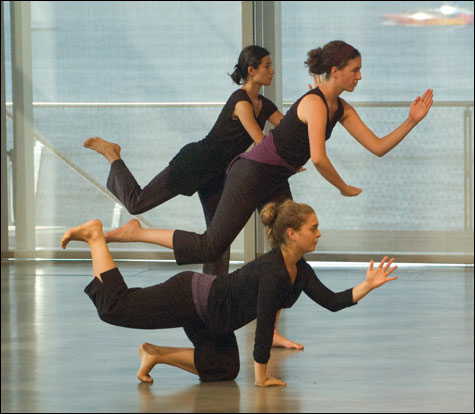
DANCING-ON-VIEW: Sarah Rudner’s workshop-performance project had an open-ended choreographic scheme. |
No startling breakthroughs occurred on our dance stages in 2008. That's okay. Conservation is a good thing in these times, and some of the most interesting performances drew on the uses of history — personal history, performance history, and even some inventions that sought to overturn history.
More than 40 years after the anti-establishment postmodern dance revolution, its devices of reform still invigorate studio and stage work. One of the great dancers of that era and this, Sara Rudner, spent the month of July in an intensive workshop-performance project at Summer Stages Dance, with shows at Concord Academy and the Institute of Contemporary Art. Rudner and a core group of New York dancers worked with eight local dancers on a series of strategies designed to develop movement and build the ensemble. The performance, called Dancing-on-View, is an ongoing model of postmodern ideas: an open-ended choreographic scheme that provokes the imagination and sparks the most personal, spontaneous instincts in each dancer.
The idea of choreography as a process or simply a plan, rather than some finished and fixed product, was crucial for many postmoderns. Among other advantages, it allows artists to interact even when they're not in the same room together. In a doubleheader at the Dance Complex, Marjorie Morgan and Karl Cronin offered solos based on instructions by postmodern star Deborah Hay. Morgan and Cronin took workshops with Hay at different times, and they came away with notes to interpret — springboards for their own creativity. The outcome was Morgan's dance, or Cronin's, as much as Hay's.
Postmodernist Lucinda Childs works much more conventionally, building her dances on musical structures, but her movement is a subtly changing organization of slimmed-down, supercharged ballet steps. Childs was on hand at the Coolidge Corner Theater to offer her soft-spoken comments after a screening of a fine new documentary about her career by French filmmaker Patrick Bensard. Her work exemplifies the postmodern insistence on neutrality as a performing position.
Instead of pursuing self-expression or goosing up the movement with artificial smiles and sexiness, the postmoderns drew attention to compositional structure, pedestrian behavior, and eclectic resources of many kinds. Dancers could boogie, sing, entertain, dress up, affect campy postures. The embrace of popular entertainment gave serious dance a permit for comedy, something neither modern dance nor ballet is noted for.
This year we got a full evening of Josh Hilberman's loopy tap inventions, Healing Powers: Rhythms of the Left Brain, at the Regent Theatre. As a bonus, he showed his film FloodHouse Dance, a short but evocative tap tour of his house after it was wrecked in a plumbing disaster.
I missed the return of David Parker's deconstructed Nutcracker, Nut/Cracked, this year (it ran in Out on the Edge's Festival of Queer Theater at the Boston Center for the Arts), but he gave his supportive and always droll presence to several other local events, among them Rudner's. Lorraine Chapman, in choreographic collaboration with Parker and Marcus Schulkind, produced Here to There at the ICA, a zany exploration of American icons from movies to modern dance itself. Sara Hook's cabaret evening at Harvard Dance Center featured the gifted Mary Cochran, assisted by Parker, riffing on early-20th-century modern dance and anxiety.